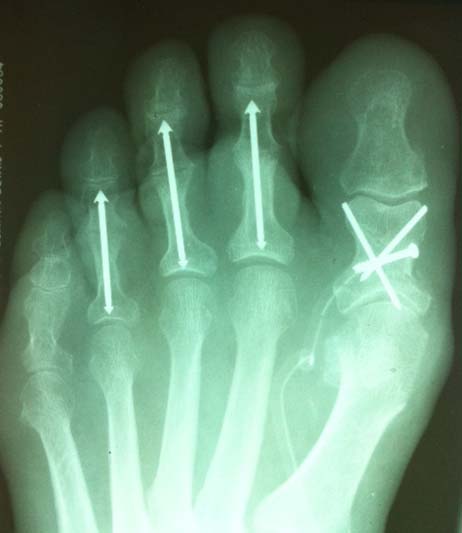
When one considers the applications for an intramedullary (IM) nail, the most common are the femur, tibia, humerus and other long bones.
However, Christopher R. Hood, Jr., DPM (Malvern, PA) observed the functional similarity of an IM device he uses in the toes with the IM nails designed for much larger bones. “During my fellowship, I was introduced to several IM devices to correct deformities in the phalanges. One device used in our practice, the ARROW-LOK® (Arrowhead Medical Device Technologies, LLC, Collierville, TN), possesses biomechanical advantages similar to those of the IM nail: a long, strong, slender cylindrical shaft inserted deeply into the dense subchondral bone at the base of the proximal phalanx and arrow-shaped elements at either end to provide stability.” The ARROW-LOK is a solution for fusion of the proximal interphalangeal joint (PIPJ), the distal interphalangeal joint (DIPJ) and both the PIPJ and DIPJ with a single implant.
Dr. Hood adds “I’ve used the ARROW-LOK for both primary and revision surgeries and have not encountered an IM anatomy into which this device would not fit when fusing either proximal or distal interphalangeal joints.” Dr. Hood along with Jason R. Miller, DPM (Exton, PA) authored an article (“Intramedullary rodding of a toe – hammertoe correction using an implantable intramedullary fusion device – a case report and review”, The Foot and Ankle Online Journal 9 (4): 1. offering a case report, a retrospective, observational study involving 35 toes and a comparison of this device to an IM nail.
The full-text article appears on The Foot and Ankle Online Journal web site (https://faoj.org/) [https://faoj.org/2016/12/31/intramedullary-rodding-of-a-toe-hammertoe-correction-using-an-implantable-intramedullary-fusion-device-a-case-report-and-review/].
PDF here – Hood, Miller – IM Rodding a toe 1701 REV 2